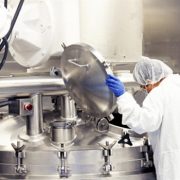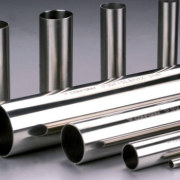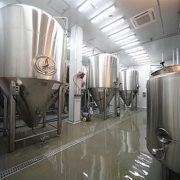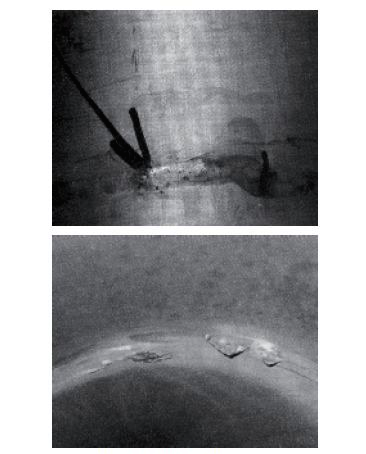The advantages of 904L stainless steel
Super austenitic stainless steel 904L (UNS N08904, EN1.4539) is a high alloy Austenitic stainless steel with low carbon content, specially designed for harsh corrosion conditions. It has high chromium content and nickel content, the addition of copper makes it has strong acid resistance especially dilute sulfuric acid, especially high resistance to chloride gap corrosion and stress corrosion cracking, is not easy to appear erosion spots and cracks, pitting resistance is slightly better than other steel. It has good machinability and weldability, in many industrial fields have a wide range of applications: petrochemical vessels and pipelines, such as reactors, etc.; Power plant flue gas desulfurization unit; Seawater treatment plant, seawater heat exchanger; Paper industry equipment, pharmaceutical industry, food industry and other fields.
Metallographic structure
904L is completely austenitic. Compared with austenitic stainless steels with high molybdenum content, 904L is insensitive to the precipitation of ferrite and α phase.
Welding performance
As with general stainless steel,904 L can be welded in a variety of ways. The most commonly used welding methods are manual arc welding or inert gas shielded welding. The electrode or wire metal is based on the composition of the base metal and has a higher purity. The content of molybdenum is higher than that of the base metal. Preheating is generally not required before welding, except in the cold outdoors, in order to avoid the condensation of water vapor, the joint part or adjacent area can be heated evenly. Note that the local temperature should not exceed 100℃, so as not to lead to carbon accumulation and cause intergranular corrosion. Small line energy, continuity and fast welding speed should be used for welding. Generally, heat treatment is not required after welding. If heat treatment is needed, it shall be heated to 1100 ~ 1150℃ and then cooled quickly. Matching welding materials: electrode (E385-16/17), welding wire (ER385).
Machining performance
The machining characteristics of 904 L are similar to those of other austenitic stainless steels, and there is a tendency for cutter stickiness and work hardening during machining. Positive front Angle carbide cutting tools must be used, with vulcanization and chlorinated oil as cutting coolant, equipment and process should be to reduce work hardening as the premise. Slow cutting speed and feed should be avoided in the cutting process.
The corrosion resistance of 904L stainless steel
904L has good activation-passivation conversion ability, it has excellent corrosion resistance, pitting resistance, good crack corrosion resistance and stress corrosion resistance in non-oxidizing acid such as sulfuric acid, acetic acid, formic acid, phosphoric acid, has good corrosion resistance, in neutral medium containing chloride ion. It is suitable for all concentrations of sulfuric acid below 70℃ and has good corrosion resistance to acetic acid and mixture of formic acid and acetic acid at any concentration and any temperature under normal pressure.
Due to the low carbon content (Max. 0.020%) of 904L, there is no carbide precipitation under normal heat treatment and welding conditions. This eliminates the potential for intergranular corrosion that normally occurs after heat treatment and welding. The high Cr-Ni- Mo content and the addition of copper make 904L passivated even in reducing environments such as sulfuric acid and formic acid. The high nickel content makes it have a low corrosion rate in the active state. In the concentration range of 0~98% pure sulfuric acid, 904L can be used at a temperature up to 40℃. In the concentration range of 0~85% pure phosphoric acid, it still has good corrosion resistance.
904L SS is superior to ordinary stainless steel in corrosion resistance to all phosphates. In highly oxidizing nitric acid, 904L has poor corrosion resistance compared to alloy steels without molybdenum. In hydrochloric acid, the use of 904L is limited to a lower concentration of 1-2%, where its corrosion resistance is better than that of conventional stainless steel. 904L steel has strong crevice corrosion resistance in chloride solutions, concentrated hydroxide solutions and hydrogen sulfide-rich environments, due to its high nickel content which reduces corrosion rates in pits and crevices. Ordinary austenitic stainless steels may be sensitive to stress corrosion at temperatures above 60 ° C in a chloride-rich environment. This sensitivity can be reduced by increasing the nickel content of the stainless steel.






 The food industry usually uses well water. The iron content in well water is quite high, which can activate iron-related bacteria and cause severe corrosion. One of the commonly used water treatment methods is to remove iron from well water in order to make food taste better and to avoid corrosion of packaging and processing equipment after cleaning and rinsing. Surface and well water also contain a number of types of microorganisms that are active in both aerobic and anaerobic conditions. Aerobic iron-related bacteria oxidize iron ions, while anaerobic iron-related bacteria reduce iron ions. These two reactions are ultimately classified as microbial corrosion (MIC). Other microorganisms may also be active in the water such as sulfuric acid-reducing bacteria, acid-producing bacteria. In the same biofilm, aerobic bacteria and (below) anaerobic bacteria may be active.
The food industry usually uses well water. The iron content in well water is quite high, which can activate iron-related bacteria and cause severe corrosion. One of the commonly used water treatment methods is to remove iron from well water in order to make food taste better and to avoid corrosion of packaging and processing equipment after cleaning and rinsing. Surface and well water also contain a number of types of microorganisms that are active in both aerobic and anaerobic conditions. Aerobic iron-related bacteria oxidize iron ions, while anaerobic iron-related bacteria reduce iron ions. These two reactions are ultimately classified as microbial corrosion (MIC). Other microorganisms may also be active in the water such as sulfuric acid-reducing bacteria, acid-producing bacteria. In the same biofilm, aerobic bacteria and (below) anaerobic bacteria may be active.